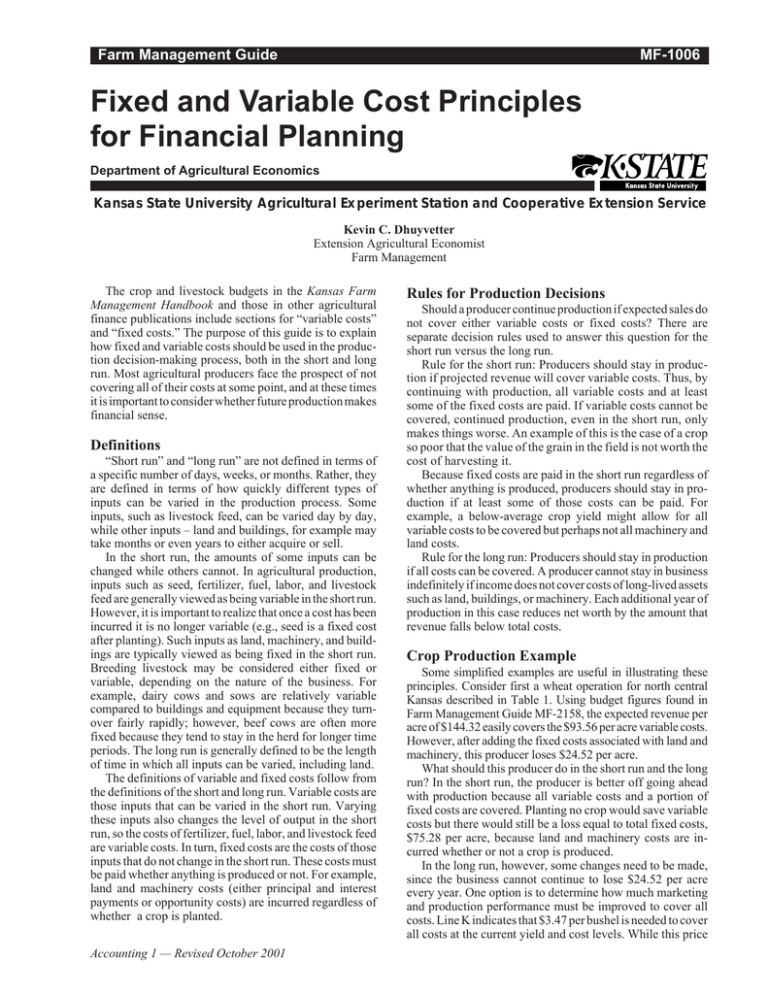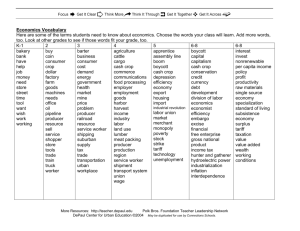
Farm Management Guide
MF-1006
Fixed and Variable Cost Principles
for Financial Planning
Department of Agricultural Economics
Kansas State University Agricultural Experiment Station and Cooperative Extension Service
Kevin C. Dhuyvetter
Extension Agricultural Economist
Farm Management
The crop and livestock budgets in the Kansas Farm
Management Handbook and those in other agricultural
finance publications include sections for “variable costs”
and “fixed costs.” The purpose of this guide is to explain
how fixed and variable costs should be used in the production decision-making process, both in the short and long
run. Most agricultural producers face the prospect of not
covering all of their costs at some point, and at these times
it is important to consider whether future production makes
financial sense.
Definitions
“Short run” and “long run” are not defined in terms of
a specific number of days, weeks, or months. Rather, they
are defined in terms of how quickly different types of
inputs can be varied in the production process. Some
inputs, such as livestock feed, can be varied day by day,
while other inputs – land and buildings, for example may
take months or even years to either acquire or sell.
In the short run, the amounts of some inputs can be
changed while others cannot. In agricultural production,
inputs such as seed, fertilizer, fuel, labor, and livestock
feed are generally viewed as being variable in the short run.
However, it is important to realize that once a cost has been
incurred it is no longer variable (e.g., seed is a fixed cost
after planting). Such inputs as land, machinery, and buildings are typically viewed as being fixed in the short run.
Breeding livestock may be considered either fixed or
variable, depending on the nature of the business. For
example, dairy cows and sows are relatively variable
compared to buildings and equipment because they turnover fairly rapidly; however, beef cows are often more
fixed because they tend to stay in the herd for longer time
periods. The long run is generally defined to be the length
of time in which all inputs can be varied, including land.
The definitions of variable and fixed costs follow from
the definitions of the short and long run. Variable costs are
those inputs that can be varied in the short run. Varying
these inputs also changes the level of output in the short
run, so the costs of fertilizer, fuel, labor, and livestock feed
are variable costs. In turn, fixed costs are the costs of those
inputs that do not change in the short run. These costs must
be paid whether anything is produced or not. For example,
land and machinery costs (either principal and interest
payments or opportunity costs) are incurred regardless of
whether a crop is planted.
Accounting 1 — Revised October 2001
Rules for Production Decisions
Should a producer continue production if expected sales do
not cover either variable costs or fixed costs? There are
separate decision rules used to answer this question for the
short run versus the long run.
Rule for the short run: Producers should stay in production if projected revenue will cover variable costs. Thus, by
continuing with production, all variable costs and at least
some of the fixed costs are paid. If variable costs cannot be
covered, continued production, even in the short run, only
makes things worse. An example of this is the case of a crop
so poor that the value of the grain in the field is not worth the
cost of harvesting it.
Because fixed costs are paid in the short run regardless of
whether anything is produced, producers should stay in production if at least some of those costs can be paid. For
example, a below-average crop yield might allow for all
variable costs to be covered but perhaps not all machinery and
land costs.
Rule for the long run: Producers should stay in production
if all costs can be covered. A producer cannot stay in business
indefinitely if income does not cover costs of long-lived assets
such as land, buildings, or machinery. Each additional year of
production in this case reduces net worth by the amount that
revenue falls below total costs.
Crop Production Example
Some simplified examples are useful in illustrating these
principles. Consider first a wheat operation for north central
Kansas described in Table 1. Using budget figures found in
Farm Management Guide MF-2158, the expected revenue per
acre of $144.32 easily covers the $93.56 per acre variable costs.
However, after adding the fixed costs associated with land and
machinery, this producer loses $24.52 per acre.
What should this producer do in the short run and the long
run? In the short run, the producer is better off going ahead
with production because all variable costs and a portion of
fixed costs are covered. Planting no crop would save variable
costs but there would still be a loss equal to total fixed costs,
$75.28 per acre, because land and machinery costs are incurred whether or not a crop is produced.
In the long run, however, some changes need to be made,
since the business cannot continue to lose $24.52 per acre
every year. One option is to determine how much marketing
and production performance must be improved to cover all
costs. Line K indicates that $3.47 per bushel is needed to cover
all costs at the current yield and cost levels. While this price
may be achieved in some years, it seems unlikely this price
could be achieved on average unless market conditions
change drastically. Line L indicates that yield would have to
rise by about 8 bushels per acre (about 18 percent) without
increasing costs at the current price level in order to
breakeven. Such a yield increase is most likely not possible
without increasing inputs.
Another option is to reduce costs without reducing yields,
which may be difficult. Fixed costs may be reduced several
ways, such as through the use of less expensive machinery,
or through more efficient use of machinery (i.e., cover more
acres with same machinery).
If all of these efforts are still unsuccessful in covering
total costs, the producer faces the decision of leaving the
farming business or finding a more profitable crop to plant.
To remain in business at the status quo means a loss in net
worth every year. In this example, a producer farming 800
acres of wheat would lose $19,616 each year on average at
the given yields, costs, and prices. Postponing the decision
to change crops or quit farming only makes this producer
worse off.
Livestock Production Example
ment Guide MF-2152. The expected gross revenue of $44.71
per head almost covers the variable costs, but is not sufficient to cover fixed costs.
When preparing budgets, it is important to calculate
expected costs, returns, and breakeven prices using various
price assumptions. Expected returns and breakeven prices
are sensitive to changes in the cost of feeder pigs. When
purchasing feeder pigs, many producers want to know what
they can afford to pay. Table 2 presents the maximum price
that can be paid for feeder pigs and still cover all costs. Given
the assumptions in Table 2, a producer could pay up to
$30.50 per head for feeder pigs and still cover all costs.
Returns over variable and total costs are also sensitive to
changes in the expected market hog price. For an expected
market hog price of $30/cwt, losses from variable and total
costs are –10.48 and –19.39 dollars per head, respectively.
In this case, a feeder pig finisher would not cover either
variable or fixed costs. A producer would be considerably
better off not finishing hogs given the costs in Table 2 and
a market price of $30/cwt. If a producer finished hogs, the
expected loss would be $19.39 per head, whereas, if a
producer did not buy feeder pigs, the loss would be equal to
the $8.91 per head fixed costs.
Another example using the fixed and variable cost principles is presented in Table 2. This budget is for an operation
finishing feeder pigs and is based on KSU Farm ManageTable 2. Per Head Production Costs, Expected Returns,
and Cost-Return Comparison for Finishing Feeder Pigs.
Table 1. Per Acre Production Costs, Expected Returns, and
Cost-Return Comparison for Wheat, North Central, Kansas.
COSTS OF PRODUCTION
A. Total variable costs
B. Total fixed costs
C. Total costs (A + B)
$ 93.56
75.28
168.84
RETURN PER ACRE:
D. Yield, bushels
E. Price, $/bushel
F. Government payment
G. Total returns [(D x E) + F]
46.00
$ 2.94
9.08
144.32
COST-RETURN COMPARISON:
H. Returns over variable costs (G – A)
I. Returns over total costs (G – C)
J. Variable cost/bushel (A ÷ D)*
K. Total cost/bushel (C ÷ D)*
L. Additional yield per acre needed
to cover revenue shortfall at
$2.94/bushel (I ÷ $2.94)
* Government payment has been factored in.
$ 50.76
-24.52
1.84
3.47
8.34
COSTS OF PRODUCTION
A. Total variable costs
B. Total fixed costs
C. Total costs (A + B)
$ 45.33
8.91
54.24
RETURN PER HEAD:
D. Market hog (260 lbs x $33.95/cwt)
E. Less cost of feeder pig
F. Less death loss (4% x D)
G. Gross return per head (D – E – F)
88.27
$ 40.03
3.53
44.71
COST-RETURN COMPARISON:
H. Returns over variable costs (G – A)
I. Returns over total costs (G – C)
J. Variable and feeder pig cost/cwt sold
[(A + E + F) ÷ 260 x 100]
K. Total and feeder pig costs/cwt sold
[(C + E + F) ÷ 260 x 100]
L. Maximum price that can be paid for
feeder pigs and still cover all costs
M. Return over variable costs given an
expected market hog price of $30/cwt
N. Return over total costs given an expected
market hog price of $30/cwt
$ -0.62
-9.53
34.19
37.62
30.50
-10.48
-19.39
Publications from Kansas State University are available on the World Wide Web at: http://www.oznet.ksu.edu
Contents of this publication may be freely reproduced for educational purposes. All other rights reserved. In each case, credit Kevin C. Dhuyvetter, Fixed
and Variable Cost Principles for Financial Planning, Kansas State University, October 2001.
Kansas State University Agricultural Experiment Station and Cooperative Extension Service
MF-1006
October 2001
It is the policy of Kansas State University Agricultural Experiment Station and Cooperative Extension Service that all persons shall have equal opportunity and access
to its educational programs, services, activities, and materials without regard to race, color, religion, national origin, sex, age or disability. Kansas State University is
an equal opportunity organization. Issued in furtherance of Cooperative Extension Work, Acts of May 8 and June 30, 1914, as amended. Kansas State University,
County Extension Councils, Extension Districts, and United States Department of Agriculture Cooperating, Marc A. Johnson, Director.





